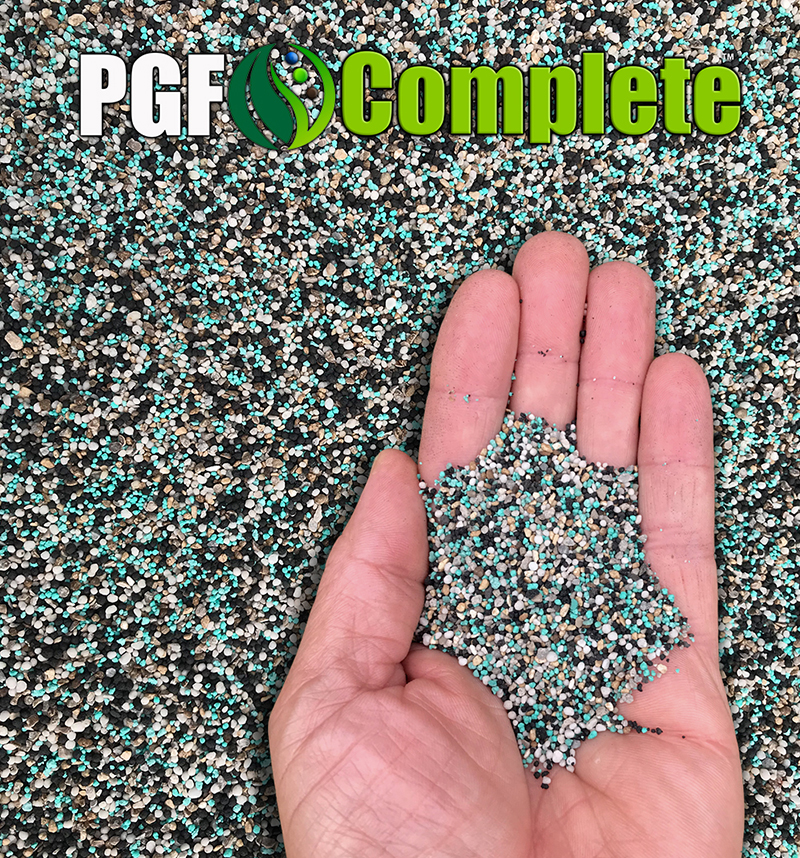What’s the best lawn fertilizer?
It has taken close to a year to bring to market, but finally the new PGF Complete lawn fertilizer is hitting the industry. In Doc’s own words… “it’s the best lawn fertilizer I have ever tested, period.” Now in stock FYI
PGF Complete is an ALL-IN-ONE lawn fertilizer that is fast acting, but still mild enough to use on lawns in the summer. It has Humic Acids, Fulvic Acids, micro nutrients, Iron, and has TINY particle size which gives amazing distribution and coverage. The 16-4-8 ratio of Nitrogen, Phosphorus, and Potassium, is the #1 basic recommended ratio for overall lawn care health.
Best Fertilizer N-P-K Ratio
Without a soil test the consensus of most experts is very clear… a balanced NPK ratio of 4-1-2 is the best fertilizer for all lawns. Yes, you will hear arguments in many ways, but the experts (and our testing) has shown that this ratio is best overall ration for a regular maintenance fertilizer.
In most cases, a rate of one pound of nitrogen per 1,000 square feet is suggested for each fertilizer application to the lawn. If high percentage nitrogen fertilizers are used, then less actual fertilizer product is needed to supply that one pound compared to fertilizers with low percent nitrogen. Recommended ratios of N-P-K for lawn fertilizers include 3:1:2 or 4:1:2 → Link to Citation
Good maintenance type fertilizers should be in a 3-1-2 ratio of nitrogen (N) to phosphorus (P) to potassium (K). An example of a 3-1-2 ratio fertilizer would be a 15-5-10 or something relatively close to this. → Link to Citation
If you have not had a soil test, apply a fertilizer that is four to six parts nitrogen, one part phosphorus and two to four parts potassium. A 16-4-8 fertilizer analysis would fall within this range with a 4-1-2 ratio of these nutrients. → Link to Citation
Use a 3-1-2 or 4-1-2 ratio fertilizer if you elect not to conduct a soil test. A common example of a 3-1-2 ratio fertilizer is 15-5-10,while a good 4-1-2 ratio fertilizer is 16-4-8.These ratios generally supply what most lawns need, and they won’t dramatically increase the phosphorus levels if it’s unneeded → Link to Citation
Humic Acid (Humic DG)
Humic acid is a natural soil conditioner that acts as an organic chelator and microbial stimulator. It has a unique carbon matrix which includes a high concentration of trace minerals and organic acids. Humic acid enhances the plant’s ability to take in essential nutrients and improves soil structure. Proven Humic Acid Benefits:
- Increases soil carbon
- Improves plant health
- Improves germination and viability of seeds
- Chelates macro and micro nutrients to increase availability to the plant for a longer period of time
- Increases cation exchange capacity (CEC)
- Improves soil structure for better aeration and water movement
- Stimulates beneficial microorganisms, which can improve long-term soil pH
- Especially effective on sandy soils
Iron…
Under normal turfgrass-growing conditions, it is common to observe a color response in turfgrass after an iron application, especially if the turfgrass is growing on a soil of neutral or alkaline pH. For the most part, turfgrasses are sensitive to iron levels and an application of iron, either to the soil or foliarly, generally imparts a darker green color to the turfgrass. Due to this response, iron is perhaps the most frequently applied micronutrient for turf-grasses. Although iron is not an actual component of the chlorophyll molecule (the green photosynthetic pigment of plants), it is an essential element that plants need to make chlorophyll. That is why iron levels affect foliage color.
The role of iron in turf nutrition Researchers have conducted many studies involving the function and necessity of iron in plants. It turns out that iron is an elusive element, and researching a plant’s requirement and making recommendations for iron is difficult. After many years of research, scientists still have not identified the exact roles of iron in plants. Although we know that iron is involved in chlorophyll synthesis and is a component of other plant tissues, questions remain concerning other roles it plays in plants. Further, attempts to correlate tissue-iron status with growth and color responses have not always revealed an obvious relationship. For this reason, few laboratories analyze soils and tissue for iron content. Lacking a strong correlation between soil- and tissue-iron content and turfgrass growth, it is difficult to make meaningful recommendations.
Turfgrasses differ in their sensitivity to iron deficiency. Generally, warm-season turfgrasses are more sensitive to iron deficiencies than cool-season turfgrasses. Differences also exist among the warm-season grasses. Centipedegrass, bahiagrass and bermudagrass tend to be more sensitive to iron levels than St. Augustinegrass and zoysiagrass. This is one reason why bahiagrass and centipedegrass usually grow better on acidic soils where iron is more available, whereas St. Augustinegrass is recommended for neutral and alkaline soils where iron is less available.
Micro Nutrients
Understanding the role of each micronutrient within the plant should provide a greater understanding of the key role these nutrients play in proper turfgrass management. Micronutrients are just as essential for proper turfgrass health as macronutrients, but are required in very small quantities compared with macronutrients. Micronutrients include iron (Fe), manganese (Mn), boron (B), copper (Cu), zinc (Zn), molybdenum (Mo), and chlorine (Cl).
- Iron: Part of the catalytic enzymes, Fe is required for chlorophyll synthesis affecting photosynthesis, nitrogen fixation, and respiration.
- Manganese: Involved in photosynthesis, Mn is required as a cofactor for about 35 enzymes. Lignin biosynthesis depends on Mn.
- Copper: Cu-protein plastocyanin is involved in photosynthesis and is a cofactor for a variety of oxidative enzymes.
- Zinc: Zn is a structural component of enzymes and is required for protein synthesis. Carbohydrate metabolism is affected by Zn
PGF Lawn Fertilizer is a COMPLETE and balanced professional grade product.
Particle Size
More particles per square foot gives PGF Complete some of the best UNIFORM performance of any fertilizer on the market.








